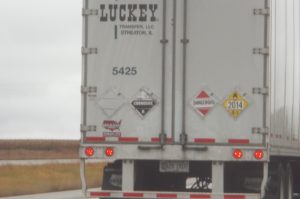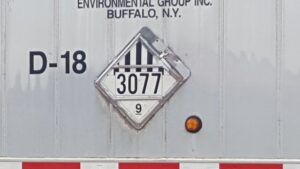A question through my website May 14, 2020:
Got a question about dangerous placard, today I picked up 10,000 pounds of bulk class 9 3077 1500 pounds non bulk class 3 400 pounds non bulk class 4.1 700 pounds non bulk class 8 30 pounds non bulk class 2.1 and 600 pounds non bulk 6.1 pgll at one facility so I put a bulk 9 3077 and a Dangerous on the trailer but my company said I could not cover the 1500 pounds of class 3 with the Dangerous because it was over 1001 pounds and that I should have put a bulk 9 3077 class 3 and a Dangerous. Who’s right and why?
My reply a few days later on May 20, 2020:
Thank you for contacting me. I will try to answer your question. Please see below.
|
Contact me with any questions you may have about the transportation of hazardous materials by air, highway, vessel, or rail International and Domestic Daniels Training Services, Inc. 815.821.1550 |
My summary of your situation:
- All hazardous materials (HazMat) were loaded on one vehicle from one location.
- Consignment includes the following:
- 10,000 lb of Class 9 Miscellaneous in bulk packagings. Identification number for this HazMat is UN3077.
- 1,500 lb Class 3 Flammable Liquid in non-bulk packagings.
- 400 lb Division 4.1 Flammable Solid in non-bulk packagings.
- 700 lb Class 8 Corrosive Material in non-bulk packagings.
- 30 lb Division 2.1 Flammable Gas in non-bulk packagings.
- 600 lb of Division 6.1 Poisonous Material (Packing Group II) in non-bulk packagings.
- Whew!

- Pursuant to 49 CFR 172.504(a) a vehicle transporting any amount of HazMat must display the applicable placards on the vehicle.
- However, §172.504(c) allows for an exception from placarding if a non-bulk packaging of placarding Table 2 HazMat, and in a quantity of less than 454 kg (1,001 lb).
- Pursuant to §172.331(c) if a bulk packaging is contained within a vehicle and the HazMat’s identification number marked on the bulk packaging is not visible, the identification number must be displayed on the vehicle.
- When the HazMat’s identification number is required to be displayed on a vehicle, it may be displayed in any of the following methods per §172.332:
- On orange panel.
- On the placard.
- On a white square-on-point.
- Under §172.502(c), placards may be displayed on a vehicle, even when not required, if the placarding otherwise conforms to the requirements of the HMR. This is known as permissive placarding.
- §172.504(b) allows for the display of the Dangerous placard on a vehicle as an option instead of the individual placards under the following conditions:
- HazMat is in non-bulk packagings.
- Vehicle contains two or more categories of HazMat that require placards specified in placarding Table 2. Note: the use of the word “require” here is misleading since, subject to permissive placarding, placards may be displayed on a vehicle even when not required. Therefore, this might better read, “vehicle contains two or more categories of HazMat where a placard type is indicated in placarding Table 2, but not necessarily required by the HMR.”
- The Dangerous placard may not be used for a HazMat if 1,000 kg (2,205 lb) or more of that HazMat is loaded on a vehicle at one facility. Note: if 1,000 kg (2,205 lb) or more of a single HazMat is loaded on a vehicle at one facility, that portion of the load on the vehicle cannot be represented by the Dangerous placard; instead the placard specified in placarding Table 2 for that HazMat must be displayed.
- Pursuant to §172.504(f)(9) the Class 9 Miscellaneous placard is not required to be displayed on a vehicle in the U.S. It is allowed to be displayed under permissive placarding; and, if in a bulk packaging, the identification number of the HazMat may be displayed on the placard, on an orange panel, or white square-on-point.
- This letter of interpretation (LOI 97-0099) is too old to be displayed on USDOT/PHMSA’s website but it indicates the quantity of a Class 9 Miscellaneous is not required to be included when determining the applicability of the placarding exception threshold (454 kg or 1,001 lb). Note: However, under permissive placarding, the quantity of Class 9 Miscellaneous may be included when determining the option to display the Dangerous placard. The HMR is unclear on this point. I submitted a request for a letter of interpretation from USDOT/PHMSA in June of 2020 and will post a link once received.
|
Daniels Training Services, Inc. 815.821.1550 |
My answer:
- You are correct.
- Since the Class 9 Miscellaneous is in a bulk packaging, it cannot be covered by the Dangerous placard.
- While the display of the Class 9 Miscellaneous placard is not required within the U.S. it may be displayed subject to permissive placarding. Also, since the Class 9 Miscellaneous is in a bulk packaging it’s identification number (3077) must be displayed on the vehicle. It’s display on the placard is one allowed option.
- Since all of the remaining HazMat loaded at the facility are non-bulk packagings, found in placarding Table 2, and not more than 1,000 kg (2,205 lb), the Dangerous placard may be used to account for the remaining HazMat.
I hope this helps. Please contact me with any other questions.
|
If you like this article, please share it using any of the social media platforms identified at the bottom of this article. You’ll look real smart recommending my articles! |
